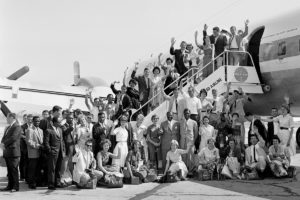# 3 Mad Men of the Peace Corps–Ghana (Washington, D.C.)
Pat was driving to D.C. when he heard on the car radio that JFK had signed the executive order creating the Peace Corps. It was March 1, 1961. He stepped on the gas and reached Washington that night. He started to work at the Peace Corps the next day.
There was no specific job, however. There were no jobs. There were 12 or so people working for the new agency: Sarge, Maryann Orlando, Sally Bowles, Nancy Gore, Mitzi Mallina. Warren Wiggins, Bill Josephson, Charlie Nelson, Gordon Boyce, Al Sims, Ed Bayley, and Harris Wofford.
“Wofford was dividing his time between the Peace Corps and the White House,” Kennedy recalls. “He interviewed me and he kept yawning in my face. I knew he was important; I’d heard about him on the campaign. He was close to Shriver. And I thought, ‘Oh my God, I’ve had it. I’m boring him to death.’
Pat wasn’t boring Wofford, it was because Wofford was working eighteen-hour days in two jobs.
Not having any office furniture in the few rooms of the ‘peace corps’ in the Maiatico Building, Pat took it upon himself to do a little ‘midnight requisitioning’ from the AID offices in the same building. It was easy, he said, as the AID people were gone by 5:00 p.m. and the new Peace Corps folks worked half the night.
His first job was answering mail. There were thousands of letters stacked up from people wanting to become Volunteers. As the building became organized, he went onto become the sole training officer for several months, and help to set up the first training programs, which were to Latin America and Africa.
Kennedy had never been to Africa, nor had anyone else. In fact, he wasn’t sure the exact geographical location of Ghana and Nigeria (first countries to get PCVs). Kennedy started to find “Africanists” on U.S. campuses and invited them to D.C. for a week of brainstorming.
David Apter came in from Berkeley; Gray Cowan from Columbia; Sinclair Drake from Roosevelt University in Chicago; Robert Lystad from Johns Hopkins. They set up the Ghana I training program at Berkeley.
Six weeks later, in mid-August 1, 1961, Ghana I was ready for Ghana. “Here today, Ghana tomorrow.” the PCVs chanted. Arriving in Accra, after having met President Kennedy at the White House, and having partied most of the night at the Ghana Embassy in D.C., they were greeted by Ghanian officials on the airport tarmac in Accra where, as a group, they sang the National Anthem of Ghana.
Kennedy recalled what the Africanists professors had told him when training began for the Ghana PCVs: It couldn’t be done in seven weeks. The Peace Corps would need two years to get the Volunteers ready for Africa.
For Pat Kennedy–as the Training Officer–it had only six and a half months since Lem Billings had called from the White House Lincoln bedroom, waking him up on a cold Wisconsin night to tell him, yes, there was going to be a Peace Corps and Sarge Shriver wanted to interview him.
His first real job at the Peace Corps was as a Trainer. It was the best job he ever had, Pat would tell Coates Redmon Come As You Are. “You were in on everything as a Trainer; you did everything,” Pat said. “You had total contact with the Volunteers, total contact with the universities who were doing the training, contact with the embassies in Washington, contact with the host country officials. You were the center of all activity. And it never got any better than that.”

There’s a book here.
Yes, I remember those Ghana-1 volunteers. Ghana-2 Teachers and Ghana-3 Geology (my group) arrived whilst they were still in-country. They were a few years older, on average, and everybody held them in esteem, if not awe. More later. John Turnbull Ghana-3 Geology – Nyasaland/Malawi-2 Geology Assignment. 1963, -64, -65.